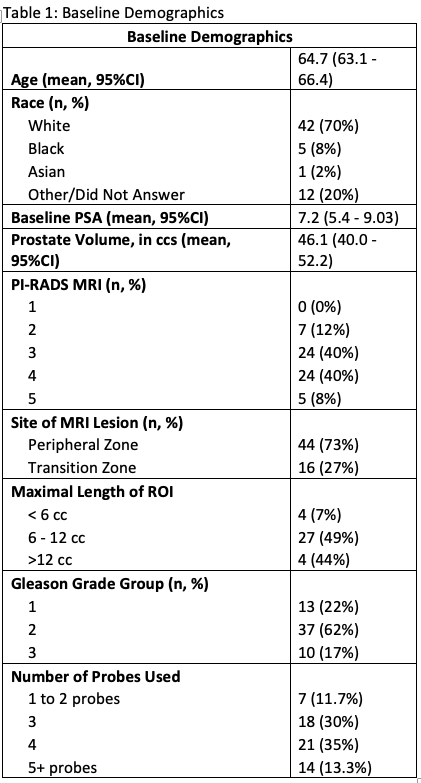Back
Poster, Podium & Video Sessions
Moderated Poster
MP55: Prostate Cancer: Localized: Ablative Therapy
MP55-10: A Prospective Longitudinal Study of Erectile Function Following Partial Gland Cryoablation for Intermediate Risk Prostate Cancer
Monday, May 16, 2022
8:45 AM – 10:00 AM
Location: Room 225
Sameer Thakker*, James Wysock, Rozalba Gogaj, Herbert Lepor, New York, NY

Sameer Thakker
NYU Grossman School of Medicine
Poster Presenter(s)
Introduction: One advantage of focal therapy over whole gland treatment for intermediate risk prostate cancer is improved preservation of erectile function (EF). The objective of our longitudinal study is to examine EF following partial gland Cryoablation (PGCA) over 24 months follow-up. The novel aspect of our study is assessing EF according to baseline severity of EF.
Methods: All men undergoing primary PGCA since 3/17 were enrolled in an IRB approved prospective outcomes registry. The present study identified 60 men with unilateral IRPCa associated with an MRI lesion who completed the self-administered Sexual Health Inventory for Men (SHIM) questionnaire at baseline and 6, 12, and 24 months. The mean SHIM scores were evaluated for all men and for subgroups created according to baseline EF: No ED (SHIM > 21) Mild/Mild to Moderate ED (SHIM 12-21), Moderate/Moderate to Severe ED (SHIM <12). We captured use of PDE5i at all visits.
Results: The baseline characteristics and time dependent changes in SHIM are shown in Tables 1 and 2, respectively. Significant decreases in mean SHIM scores were observed for the entire group, the No ED, and Mild/mild to moderate ED subgroups between baseline and 6 months. There was a trend for mean SHIM scores to improve from 6 months to 12 months and stabilize between 12 to 24 months for all sub-groups. The post-treatment SHIM scores were not influenced by PDE5i since 36%, 48%, 36% and 37% men were taking PDE5i at baseline, 6, 12, and 24 months, respectively.
Conclusions: PGCA is associated with a modest, yet significant short term adverse impact on sexual health based on our longitudinal analysis. The trend for increasing SHIM scores between 6 to 12 months may reflect plasticity of nerve regrowth as seen following radical prostatectomy. The decrease in mean SHIM scores for the total group is blunted by the lack of adverse impact in men with moderate/severe ED. While the greatest absolute change in SHIM scores was observed in men with no baseline ED, this cohort retains good quality erections based on post treatment scores.
Source of Funding: N/A


Methods: All men undergoing primary PGCA since 3/17 were enrolled in an IRB approved prospective outcomes registry. The present study identified 60 men with unilateral IRPCa associated with an MRI lesion who completed the self-administered Sexual Health Inventory for Men (SHIM) questionnaire at baseline and 6, 12, and 24 months. The mean SHIM scores were evaluated for all men and for subgroups created according to baseline EF: No ED (SHIM > 21) Mild/Mild to Moderate ED (SHIM 12-21), Moderate/Moderate to Severe ED (SHIM <12). We captured use of PDE5i at all visits.
Results: The baseline characteristics and time dependent changes in SHIM are shown in Tables 1 and 2, respectively. Significant decreases in mean SHIM scores were observed for the entire group, the No ED, and Mild/mild to moderate ED subgroups between baseline and 6 months. There was a trend for mean SHIM scores to improve from 6 months to 12 months and stabilize between 12 to 24 months for all sub-groups. The post-treatment SHIM scores were not influenced by PDE5i since 36%, 48%, 36% and 37% men were taking PDE5i at baseline, 6, 12, and 24 months, respectively.
Conclusions: PGCA is associated with a modest, yet significant short term adverse impact on sexual health based on our longitudinal analysis. The trend for increasing SHIM scores between 6 to 12 months may reflect plasticity of nerve regrowth as seen following radical prostatectomy. The decrease in mean SHIM scores for the total group is blunted by the lack of adverse impact in men with moderate/severe ED. While the greatest absolute change in SHIM scores was observed in men with no baseline ED, this cohort retains good quality erections based on post treatment scores.
Source of Funding: N/A



.jpg)
.jpg)